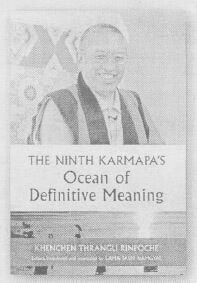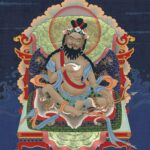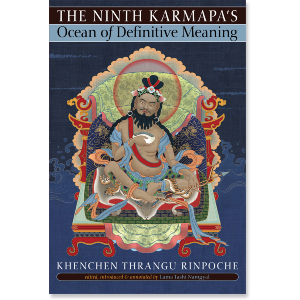| The following article is from the Autumn, 2003 issue of the Snow Lion Newsletter and is for historical reference only. You can see this in context of the original newsletter here. |

The most in-depth and famed text on Mahamudra ever written, The Ocean of Definitive Meaning by the 9th Karmapa offers a detailed, uniquely comprehensive presentation. Thrangu Rinpoche has distilled the essence of the 9th Karmapa's massive text and gives guidance in implementing the instructions.
The availability of the translation of this text has traditionally been restricted to advanced students only. However Khenchen Thrangu Rinpoche has consented to the publication of these core teachings. He believes Mahamudra is especially appropriate for Westerners because it can be realized in the context of virtually any lifestyle, revealing the radiant display of mind. Compelling, systematic approach to some of the highest teachings in the Kagyu tradition.
Here is an excerpt from chapter 6:
The first question posed is, "What is your mind's nature like?" At this point you have been practicing insight meditation and looking at the mind's nature directly in the way, for example, you would watch the behavior of a bird. You have been looking to see how the mind comes to rest, how the mind moves, and so on. There are several things you might have experienced and that therefore might constitute your answer to this first question. You might say, "Well, there is nothing to find; I cannot find anything; there is simply nothing there." Or you might say, "What 1 experience is a kind of vague obscurity, a sort of darkness." Or you might say, "What I've experienced is lucidity, a kind of knowing."
Another question posed is whether or not there is any difference in your experience between the practice of tranquility meditation and this first practice of insight meditation. Previously, when you were practicing tranquility alone, you brought your mind to a state of rest in a natural way. Now, what you are doing in the initial practice of insight is looking at the mind within that state of rest or stillness. Is the experience of looking at the mind within stillness any different from the experience of stillness itself, of the experience of tranquility alone? It might be exactly the same; there might be no difference whatsoever, or it might be slightly different. If you say that there is no difference whatsoever, that the experience of looking at the mind within stillness and the experience of just achieving a state of stillness itself are not different, then you are still just practicing tranquility. There is as yet no practice of insight, and the text says that you need to remember that tranquility alone, while it can weaken kleshas, cannot eradicate them; it cannot generate great wisdom. So, if there is no difference between this first practice of insight and the practice of tranquility, you need to keep looking. If there is a difference, if in your experience looking at the mind within stillness and simply resting in stillness are slightly different, then our text says you probably have a partial experience of your mind's nature, in which case you should continue in the same way.

...what you are looking at is the nature of your own mind. Your mind, which is looking, is fully capable of seeing its own nature. I It is not something that I is distant from you or hidden from you in any way.
About looking at the mind, it was written by the Third Gyalwang Karmapa, Rangjung Dorje, in his Aspiration of Mahamudra, When one looks repeatedly at the mind which cannot be viewed or cannot be looked at. That line indicates that, when you look at your mind, there is no object to be seen in the visual sense of something you can look at physically. He continues, When you do so, you vividly see that which cannot be seen. Vivid seeing is what we call insight or lhaktong (in Sanskrit, vipashyana). That which cannot be seen is the mind, which is not an object that is in any way separate from that which is looking. This kind of looking is not like looking outside yourself at trees or hills or buildings, and so on. Yet, while it is not an object to be viewed outside the looker, it can be experienced. There is an experience, which here is called vividly seeing that which cannot be seen.
Now, when we look at the mind in this way, we are not trying to condition or alter the mind in any way. We are not trying to convince ourselves that that which does not exist, exists. We are not afraid of finding nothing and so are trying to find something. Nor are we trying to convince ourselves that that which exists, does not exist. We are not afraid of finding something and are not desperate to turn it into nothing. When we describe the mind, we have to say that it is not something in the usual sense of that word, because it has none of the substantial characteristics that we normally associate with words like something or existence. But we also cannot say that it is nothing, because when we say nothing, we mean nothing at all, absolutely nothing. If the mind were nothing in that sense, then it would be an utter absence, like the absence of mind in a corpse. The mind is not nothingness.
Now, in order to attempt to communicate this state or characteristic of the mind, mahasiddhas have used different terminology. They have sometimes referred to it as the unity of cognitive lucidity and emptiness, or as the unity of the expanse and wisdom. Sometimes they simply say that it is inexpressible and beyond words. In any case, it is this nature, which cannot be easily characterized as one thing or another, that we are attempting in this practice to experience directly.
The previously quoted stanza by Rangjung Dorje goes on to say, "If you vividly see that which cannot be seen, you cut through doubt about any kind of, 'It is this,' or 'It is not this;' 'It is that,' or 'It is not that.'" The last line of the stanza, which makes it an aspiration, reads, "May I see this just as it is without bewilderment or confusion." It is appropriate to make this aspiration and to attempt to accomplish it through practice, because what you are looking at is the nature of your own mind. Your mind, which is looking, is fully capable of seeing its own nature. It is not something that is distant from you or hidden from you in any way. It is, therefore, most important to put the effort into looking at the mind in this way.


